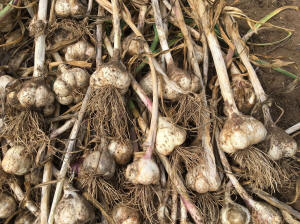|

Harvest Garlic and Replant with Quick-Maturing Vegetables
By Melinda Myers
[July 12, 2025]
Get the best
flavor and longest storage life from your homegrown garlic with
proper harvesting, curing and storage. Then fill that space with a
quick-maturing vegetable for a tasty fall harvest.
Harvest garlic when approximately one third, but less than half of
the leaves turn brown. Start by digging one plant to check the
garlic for maturity. Cloves should be plump and fill the skin. |
|
Immature garlic does not store well, while
over-mature bulbs are more subject to disease. Don’t discard but
rather use immature garlic as soon as possible.
Cure the garlic you plan to store for three to four weeks in a warm,
well-ventilated location. Once dried, remove soil, long roots and
only the damaged outermost layer of papery skin with a brush of your
gloved hand. Cut off the tops being careful not to damage the papery
covering that protects the cloves.
Store the garlic in a cool location with good air circulation and
out of direct sunlight to prevent resprouting. Properly harvested
and cured garlic will last for up to eight months.
Garlic can also be frozen. Place the whole bulb, individual cloves,
or peeled, chopped cloves in a single layer in a plastic freezer
bag. Use frozen garlic to flavor your favorite recipes within three
to four months for the best flavor.
Once harvested, prepare the area for another planting. Spread a
layer of compost over the area or incorporate an inch of compost
into the top six inches of soil and fertilize if needed.
Calculate the number of frost-free days remaining in your growing
season. Simply count the number of days from planting to the date of
the average first fall frost in your area. Select and plant
vegetable seeds and transplants that will be ready to harvest before
the first killing frost in fall. Check the back of the seed packet
or plant tag for the number of days from planting to harvest. If
there is enough time for the summer planting to grow and produce
before the first killing frost, they can be added to the garden. Or
extend the season with cold frames and floating row covers to
protect plantings as needed from killing frost.
Depending on the variety, cucumbers and bush beans are ready to
harvest in as few as 60 days. Enjoy great flavor from summer
plantings of broccoli and cabbage transplants harvested during the
cooler months of fall. Sow seeds of radishes, beets, carrots and
other quick-maturing vegetables for a fall harvest.
[to top of second column] |

Once your seeds and transplants are in the ground, be
sure to water properly. Keep the seedbed and roots of transplants
moist for the first few weeks. Gradually reduce watering frequency
as seedlings sprout and grow and transplants become established.
Help keep the soil cool by mulching plantings with shredded leaves,
evergreen needles or other organic mulch.
Enjoy the rewards of all your planning, planting and care with
bountiful harvests now through the end of the season.
Melinda Myers has written more than 20 gardening books,
including the Midwest Gardener’s Handbook, 2nd Edition and Small
Space Gardening. She hosts The Great Courses “How to Grow Anything”
instant video and DVD series and the nationally syndicated Melinda’s
Garden Moment TV & radio program. Myers is a columnist and
contributing editor for Birds & Blooms magazine and was commissioned
by Summit for her expertise to write this article. Myers’ website is www.MelindaMyers.com.
[Photo courtesy of MelindaMyers.com]
 |